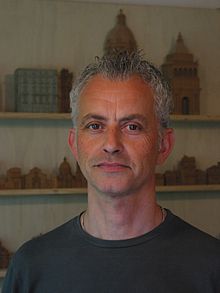- Cittacotte
-
The cittacotte are miniature copies of historical or monumental buildings of Palermo and other Italian cities made only in terracotta. The word cittacotte was invented by Vincenzo Vizzari, and it is composed by the two terms: città (Italian: city) and cotte (Italian: baked), meaning that they represent miniatures made of baked clay.
The monuments are reproduced in scale (1:180 and 1:350) and can vary in size from a minimum height of cm 1.5 up to cm 60. The typology of monuments and buildings reproduced is varied: monumental city doors, churches, historical buildings, but also common buildings of the centre of the city.[1]
Contents
Making the Cittacotte
The preparatory phase of a single cast is long and laborious: it consists in creating some clay prototypes which will be necessary to make their plaster casts. Each cast is made by photographic and metric surveys that allow the artist to take care also of the shrinkage coming from the evaporation during the modelling and the cooking phases. The result is a perfect handcrafted masterpiece in scale 1:350 or 1:180, exact in each single particular.[2][3]
The cast or the casts, for more complex models, are used to give a first shape to the clay parts that, once sketched, can be modelled and finished by hand. The making of a medium complexity model like the Palermo's Porta Nuova can require six hours of intense manual labour. The cooking phase requires, for a little dimension model, about two hours of baking to complete the drying phase. After that the artist can start the finishing, fully manually, and the polishing using a little wax film to enhance the contrast of shades and the reflective property of clay. The result is a jewel made to allow his owner to keep a little piece of Sicily in his own home.
- Cittacotte: making of Palermo's Porta Nuova in six shots
Vincenzo Vizzari
Vincenzo Vizzari is an architect from Palermo. Since 1993, he has been working as a full time artist and artisan in his little workshop in Corso Vittorio Emanuele in Palermo[4]. In his life he made a radical choice and that choice led him to specialize in the creation of cittacotte, finally joining his love for architecture together with his love for making in an artisan way.[5]
Collecting
There is an emerging hobby devoted to collecting cittacotte because some of miniatures are made in limited editions. More than this, it is possible to realize large part of Sicilian town putting together the perfect reproduction of building in scale.
See also
References
External links
- Cittacotte - Official website of the artist
- Gokutabi Italia - Web - Japanese article about Vincenzo Vizzari's cittacotte
- YouTube's Cittacotte channel - Videos of the artist while creating
Categories:- Arts and crafts
- Artisans
- Crafts
- Terracotta
Wikimedia Foundation. 2010.










